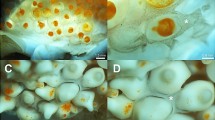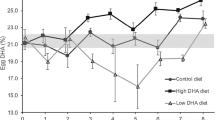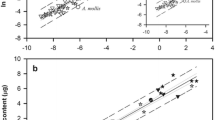Abstract
Seahorses, sea dragons and pipefishes of the teleost family Syngnathidae are unique in that embryos develop within specialized brooding structures of the male. We enriched brooding Syngnathus fuscus and Syngnathus floridae males with injections of L-lysine-[15N2] and 16:0-palmitic acid 1-[13C] to demonstrate embryonic uptake of paternally-derived nutrients. While all embryos demonstrated amino acid enrichment, late stages showed significantly higher [15N], indicating greater utilization of paternal resources as yolk reserves diminished and embryonic energy demands increased. Limited embryonic [13C] uptake, defined as less than 10% of adult enrichment, in 75 and 81% of S. floridae and S. fuscus respectively signified rapid lipid metabolism and thus the need for greater enrichment. Interspecific differences in embryonic uptake of paternally-derived nutrients were not demonstrated. However, interspecific differences in egg nutrient reserves and fry size but comparable fry nutrient levels along with data from a published paternal exposure study indicate paternal transfer in S. fuscus most likely compensates for the comparative egg nutrient deficiency. This study is the first to our knowledge to provide direct evidence for the functional significance of the brood pouch in nutrient provisioning. These results add comparative information on the diversity of Syngnathid paternal care and further our understanding of paternal influence on development.




Similar content being viewed by others
References
Ahnesjö I (1992) Consequences of male brood care: weight and number of newborn in a sex-role reversed pipefish. Funct Ecol 6:274–281
Ahnesjö I (1995) Temperature affects male and female potential reproductive rates differently in the sex-role reversed pipefish, Syngnathus typhle. Behav Ecol 6:229–233
Battaglia FC, Regnault TRH (2001) Placental transport and metabolism of amino acids. Placenta 22:145–161
Berglund A, Rosenqvist G, Svensson I (1986) Reversed sex roles and parental energy investment in zygotes of two pipefish (Syngnathidae) species. Mar Ecol Prog Ser 29:209–215
Berglund A, Rosenqvist G, Svensson I (1989) Reproductive success of females limited by males in two pipefish species. Am Nat 133:506–516
Booth C, Elphick MC, Hendrickse W, Hull D (1981) Investigation of [14C] linoleic acid conversion into [14C] arachidonic acid and placental transfer of linoleic and palmitic acids across the perfused human placenta. J Dev Physiol 3:177–189
Boutton TW (1991) Stable carbon isotope ratios of natural materials: I. sample preparation and mass spectrometric analysis. In: Coleman DC, Fry B (eds) Carbon isotope techniques. Academic Press, New York, pp 155–171
Carcupino M, Baldacci A, Mazzini M, Franzoi P (1997) Morphological organization of the male brood pouch epithelium of Syngnathus abaster Risso (Teleostea, Syngnathidae) before, during, and after egg incubation. Tissue Cell 29:21–30
Carcupino M, Baldacci A, Mazzini M, Franzoi P (2002) Functional significance of the male brood pouch in the reproductive strategies of pipefishes and seahorses: a morphological and ultrastructural comparative study on three anatomically different pouches. J Fish Biol 61:1465–1480
Coplen TB, Hopple JA, Böhlke JK, Peiser HS, Rieder SE, Krouse HR, Rosman KJR, Ding T, Vocke RD, Révész KM et al (2002) Compilation of minimum and maximum isotope ratios of selected elements in naturally occurring terrestrial materials and reagents. United States geological survey water resources investigations report 01-4222
Duncker G (1915) Revision der Syngnathidae. Jahrbuch der Hamburgischen Wissenschaftlichen Antalten 32:9–120
Dzyuba B, Van Look KJW, Cliffe A, Koldewey HJ, Holt WV (2006) Effect of parental age and associated size on fecundity, growth and survival in the yellow seahorse Hippocampus kuda. J Exp Biol 209:3055–3061
Ehleringer JR, Rundel PW (1989) Stable isotopes: history, units, and instrumentation. In: Rundel PW, Ehleringer JR, Nagy KA (eds) Stable isotopes in ecological research. Springer-Verlag, New York, pp 1–16
Hamlett WC, Schwartz FJ, DiDio LJA (1987) Subcellular organization of the yolk syncytial- endoderm complex in the preimplantation yolk sac of the shark, Rhizoprionodon terraenovae. Cell Tissue Res 247:275–285
Hamlett WC, Eulitt AM, Jarrell RL, Kelly MA (1993) Uterogestation and placentation in elasmobranches. J Exp Zool 266:347–367
Haresign TW, Shumway SE (1981) Permeability of the marsupium of the pipefish Syngnathus fuscus to [14C]-alpha amino isobutyric acid. Comp Biochem Physiol 69A:603–604
Herald ES (1959) From pipefish to seahorse—a study of phylogenetic relationships. Proc Calif Acad Sci 29:465–473
Jansson T, Scholtbach V, Powell TL (1998) Placental transport of leucine and lysine is reduced in intrauterine growth restriction. Pediatr Res 44:532–537
Jobling M (1995) Environmental biology of fishes. Chapman & Hall, New York
Jones AG, Avise JC (1997) Micorsatellite analysis of maternity and the mating system in the Gulf pipefish Syngnathus scovelli, a species with male pregnancy and sex-role reversal. Mol Ecol 6:203–213
Larqué E, Demmelmair H, Berger B, Hasbargen U, Koletzko B (2003) In vivo investigation of the placental transfer of 13C-labeled fatty acids in humans. J Lipid Res 44:49–55
Lockwood S (1867) The seahorse (Hippocampous hudsonius) and its young. Am Nat 1:225–234
MacCoss MJ, Wu CC, Matthews DE, Yates JR (2005) Measurement of the isotope enrichment of stable isotope-labeled proteins using high-resolution mass spectra of peptides. Anal Chem 77:7646–7653
Marsh-Matthews E, Skierkowski P, DeMarais A (2001) Direct evidence for mother-to-embryo transfer of nutrients in the livebearing fish Gambusia geiseri. Copeia 2001:1–6
Masonjones HD (2001) The effect of social context and reproductive status on the metabolic rates of dwarf seahorses (Hippocampus zosterae). Comp Biochem Physiol 129A:541–555
Orth RJ, Heck KL (1980) Structural components of eelgrass (Zostera marina) meadows in the lower Chesapeake Bay–fishes. Estuaries 3:278–288
Ripley JL, Foran CM (2006a) Population structure, growth rates, and seasonal abundance of two Syngnathus pipefish species. Estuar Coast 29:1161–1171
Ripley JL, Foran CM (2006b) Differential parental nutrient allocation in two congeneric pipefish species (Syngnathidae: Syngnathus spp.). J Exp Biol 209:1112–1121
Ripley JL, Foran CM (2008) Interspecific differences of parental polychlorinated biphenyl exposure on nutrient availability, egg production and brooding in two Syngnathus species. J Fish Biol 72:1369–1385
Robinson D (2001) δ 15N as an integrator of the nitrogen cycle. Trends Ecol Evol 16:153–162
Ryan BC, Vandenbergh JG (2002) Intrauterine position effects. Neurosci Biobehav Rev 26:665–678
Shearer G, Kohl DH (1993) Natural abundance of 15N: fractional contribution of two sources to a common sink and use of isotope discrimination. In: Knowles R, Blackburn TH (eds) Nitrogen isotope techniques. Academic Press, New York, pp 89–125
Stölting KN, Wilson AB (2007) Male pregnancy in seahorses and pipefish: beyond the mammalian model. Bioessays 29:884–896
Stürup S, Hansen HR, Gammelgaard B (2008) Application of enriched stable isotopes as tracers in biological systems: a critical review. Anal Bioanal Chem 390:541–554
Swain R, Jones SM (1997) Maternal-fetal transfer of 3H-labelled leucine in the vivparous lizard Niveoscincus metallicus (Scincidae: Lygosominae). J Exp Zool 277:139–145
Szabo AJ, Lellis R, Grimaldi RD (1973) Triglyceride synthesis by the human placenta. Am J Obstet Gynecol 15:257–262
Vincent A, Ahnesjo I, Berglund A, Rosenqvist G (1992) Pipefishes and seahorses: are they all sex role reversed? Trends Ecol Evol 7:237–241
Watanabe S, Kaneko T, Watanabe Y (1999) Immunocytochemical detection of mitochondria-rich cells in the brood pouch epithelium of the pipefish, Syngnathus schlegeli: structural comparison with mitochondria-rich cells in the gills and larval epidermis. Cell Tissue Res 295:141–149
Acknowledgments
We thank the Marine Science Consortium of Wallops Island, Virginia for the use of their facility and equipment. We also thank B. Blaine, J. Marshall, A. Martin, W. Sites and B. Shock for assistance in field collections and R. Thomas for the use of his microbalance. Stable isotope analysis was performed by the Idaho Stable Isotope Laboratory. Pipefish collection was approved by the Commonwealth of Virginia Marine Resources Commission (permit 07-41). All animal care and methods complied with regulations enforced by the West Virginia University Animal Care and Use Committee (protocol number 03-0501, November 2003). This research was supported by the National Science Foundation grant IOS-0722120.
Author information
Authors and Affiliations
Corresponding author
Additional information
Communicated by H. V. Carey.
Rights and permissions
About this article
Cite this article
Ripley, J.L., Foran, C.M. Direct evidence for embryonic uptake of paternally-derived nutrients in two pipefishes (Syngnathidae: Syngnathus spp.). J Comp Physiol B 179, 325–333 (2009). https://doi.org/10.1007/s00360-008-0316-2
Received:
Revised:
Accepted:
Published:
Issue Date:
DOI: https://doi.org/10.1007/s00360-008-0316-2




